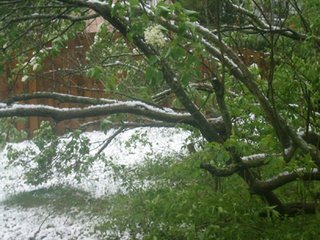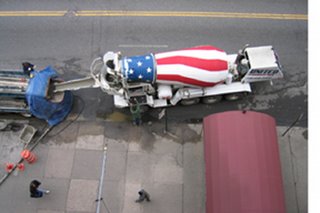
I saw something today in this old photo of the house where I grew up.
Which memories are ours? Which flow from stories we have been told, family legend and myth, year after year until we can recite them by heart?
My home is a ghost.
Like a phantom limb, I recall my home, sometimes dream of it, haunted by the memory, the textures. It itches and burns that I can’t recall it fully; I wish I could remember how the house smelled, the specific color of the light that filtered through the dust on its windows. When I lived there, the windows wouldn’t have been immaculate. It was the 1960s and ‘70s, and my family wasn’t concerned with Martha Stewart cleanliness. An old farmhouse, I don’t know when it was built, or whether the windows I looked through were its first windows.
My house was sacrificed to expand the park next door. What was our driveway now leads to a soccer field. I remember being glad--if my house disappeared, at least no one else would get to live in it. My house was burned as a fire exercise (how routine and usual that word made it sound, almost boring!), and as an adult I can appreciate that: the death of my house helped firefighters learn how to save other homes. But in a more perfect world, I wish I could have stayed in that house, returned to it from college, and after. Perhaps I am clinging to childhood, grabbing hold of something that never was. We were renters, so we couldn’t affect the fate of that house. Only, at my mother’s request, before the orchestrated arson, the village relocated one year’s live Christmas tree to the east edge of the lot. Today, that evergreen is the only living thing left of my home. (The tree was probably 5 feet tall when it was our Christmas tree. Seeing it now, thirty feet tall, taller, always amazes me.) A marker, an homage to our house.
And that house marked me. The one time I had to have stitches as a kid was when I ran from the landing upstairs down sixteen steps (was it sixteen? Did I ever actually count?) and through the kitchen, dining, and living rooms, arms extended in front of me, to push open the glass storm door, which shattered around my body. Somehow, the only damage was a cut in my right underarm, only five stitches needed (but oh, how I recall screaming at the light in my face in the doctor’s office!). Perhaps because it involved fear and physical pain, that was my own glass-shard memory, not pulled from the family epics. I still have a scar under my arm, which I unconsciously touch sometimes, run fingers over the ghost-wound’s raised tissue, proving that the house really existed.
In many ways, maybe in every way, the childhood home of my generation is gone too. No one I knew locked their doors. We kids spent days at the pool in the park next door, only going home for meals, and rode the new bike path along West South College Street downtown for Steiff little bears or beaded necklaces, no helmets, no pads, bare feet against rubber pedals; once I caught my toe in the spokes and it bled like water. But, after my foot was bandaged up and had healed enough, I got back on my bike, maybe still barefoot, and went onward, breezing through the streets tourists now call quaint. Those streets, our streets, are quaint. For our quaintness, we are praised and objectified. For our quaintness, we sometimes stagnate in a utopian memory that we’re not sure ever existed. But quaint is too tiny to describe the potholes, the puddles I tromped through, quaint won’t sanitize the mud from our superficially idyllic town, full of unsavory shadows, quaint won’t scour those memories, those apparitions.
Everyone has visceral memories of childhood. But here, in my narrow, sentimental view of our little Whoville, those ghostly memories were captured like fireflies in a glass Deaf Smith peanut butter jar, holes can-opener punched in the lid, and somehow, for me, in the morning, those fireflies weren’t dead carcasses. Sleeping? Maybe.
So I moved back.
I recall the moment I decided to return to my home town. Visiting from Seattle, where I lived for seven years, I was sitting at the counter at the a local cafe, looking out at people passing on the sidewalk with my then boyfriend. Unprompted, he said, “I could live here.” For some reason, when he said that, I began to cry. At the time I thought they were happy tears, but now I know they were bittersweet--moving back home would be a complex, beautiful salve for me (are those the fireflies I see, and are they waking?) but a very painful compromise for him, a home that wouldn’t last. I remember thinking at the time, though, looking through the old glass of the cafe storefront, how exciting, how right it would be to honor my childhood, reconnect with home.
Now, a new, adult view of town pleases me. Now I sip wine and write novels at that cafe, which some good friends bought last year. Many things provide fuel, inspiration for creative work, for life, for renewal. And slowly I’ve come to understand that just because my actual house isn’t here anymore, my home merely expanded. The womb of home is larger, and includes all of my hometown. Not only the town itself, but its satisfying, imperfect myth. The firefly memory.
* * *
Last year, when my new husband and I bought a house three miles from town, I was thrilled to keep our telephone prefix, to still have a hometown mailing address. I love our new home. And I mean no disrespect, but when people ask me how’s the next town over, I’m quick to clarify that technically, we still live in my hometown.
Real estate. Real estate. Growing up, my family rented, so we had to vacate when the village expanded the park. Maybe that’s why, even with the allure of Seattle seducing me, I felt such a pull to come home. For decades now, I have periodically dreamed of that house at 318 West South College Street. (Don’t look for it, it isn’t there.) I have immortalized it in a novel.
Dreams about 318 West South College Street are as welcome to me as dreams of flying.
In my most recent dream, the house was still there. Untouched since my family moved out over 20 years ago, it was for sale. My husband and I went to look, we would buy it, clean it up, renovate. Reclaim. But if it were still there, could we actually afford to buy it now? Would it have been restored by someone else, some stranger, and sold at a crazy-high market value? And what is the market value of a ghost?






